Crime, Policy, and Governance: Coerced Drug Treatment Analysis Report
VerifiedAdded on 2021/01/02
|9
|2921
|38
Report
AI Summary
This research report delves into the multifaceted relationship between crime, policy, and governance, with a specific focus on anti-social behavior and drug abuse in Australia. The report begins by defining crime and governance, highlighting the issue of anti-social behavior, particularly among young people. It then examines government policies aimed at curbing deviant behavior, with an emphasis on the National Drug Strategy and the concept of legally coerced drug treatment for offenders. The report provides definitions of substance abuse and explores the various types of illicit drugs, such as cannabis, MDMA, and heroin, that contribute to anti-social behavior. The core of the report analyzes the policy goals, including the application of restorative justice principles in coerced treatment programs. A critical analysis of restorative justice is presented, discussing its strengths, limitations, and its role in the criminal justice system. The report concludes by evaluating the ethical considerations and effectiveness of the government's approach to addressing substance abuse and its impact on crime, including the establishment of drug courts for speedy justice and resolution of related matters.
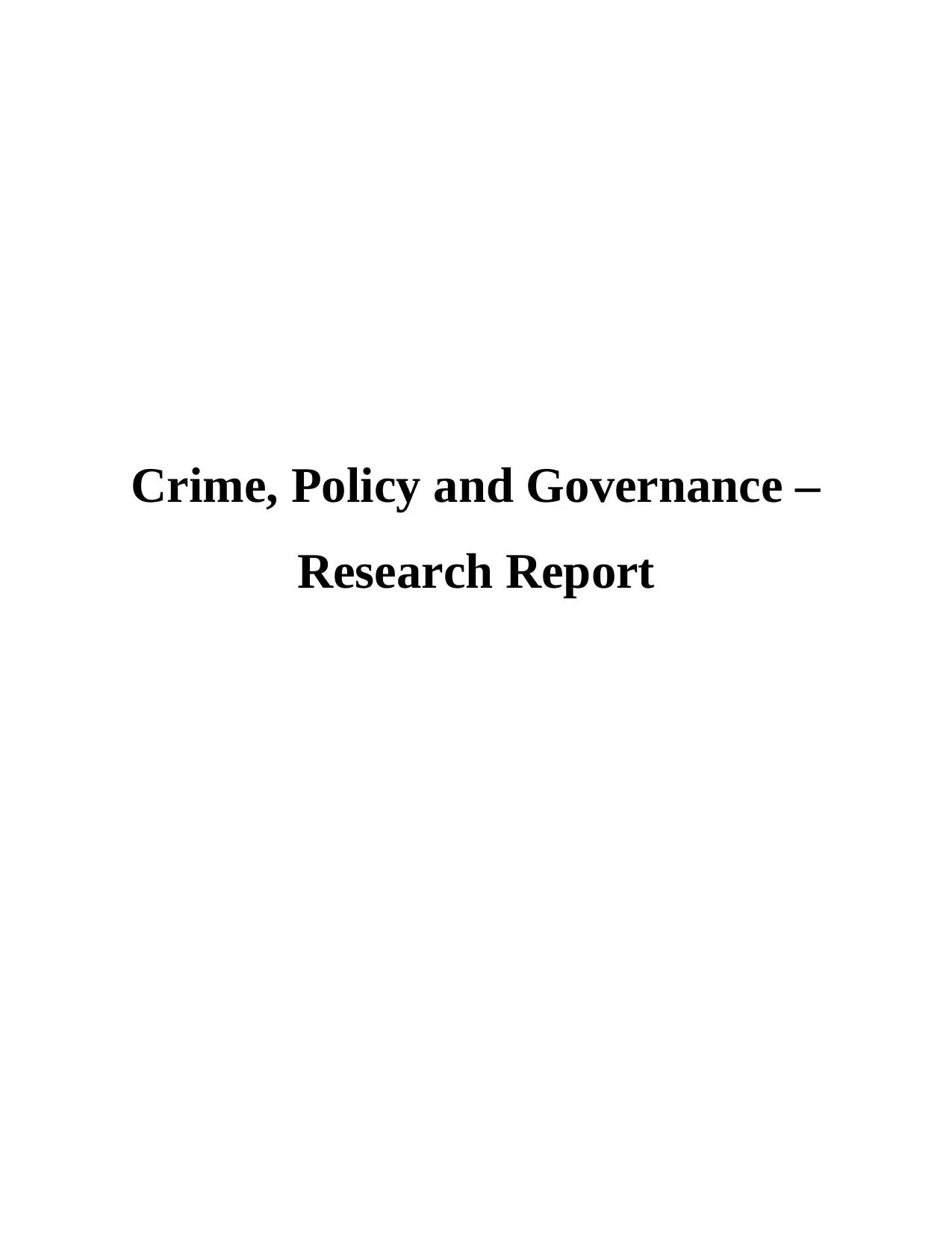
Crime, Policy and Governance –
Research Report
Research Report
Paraphrase This Document
Need a fresh take? Get an instant paraphrase of this document with our AI Paraphraser
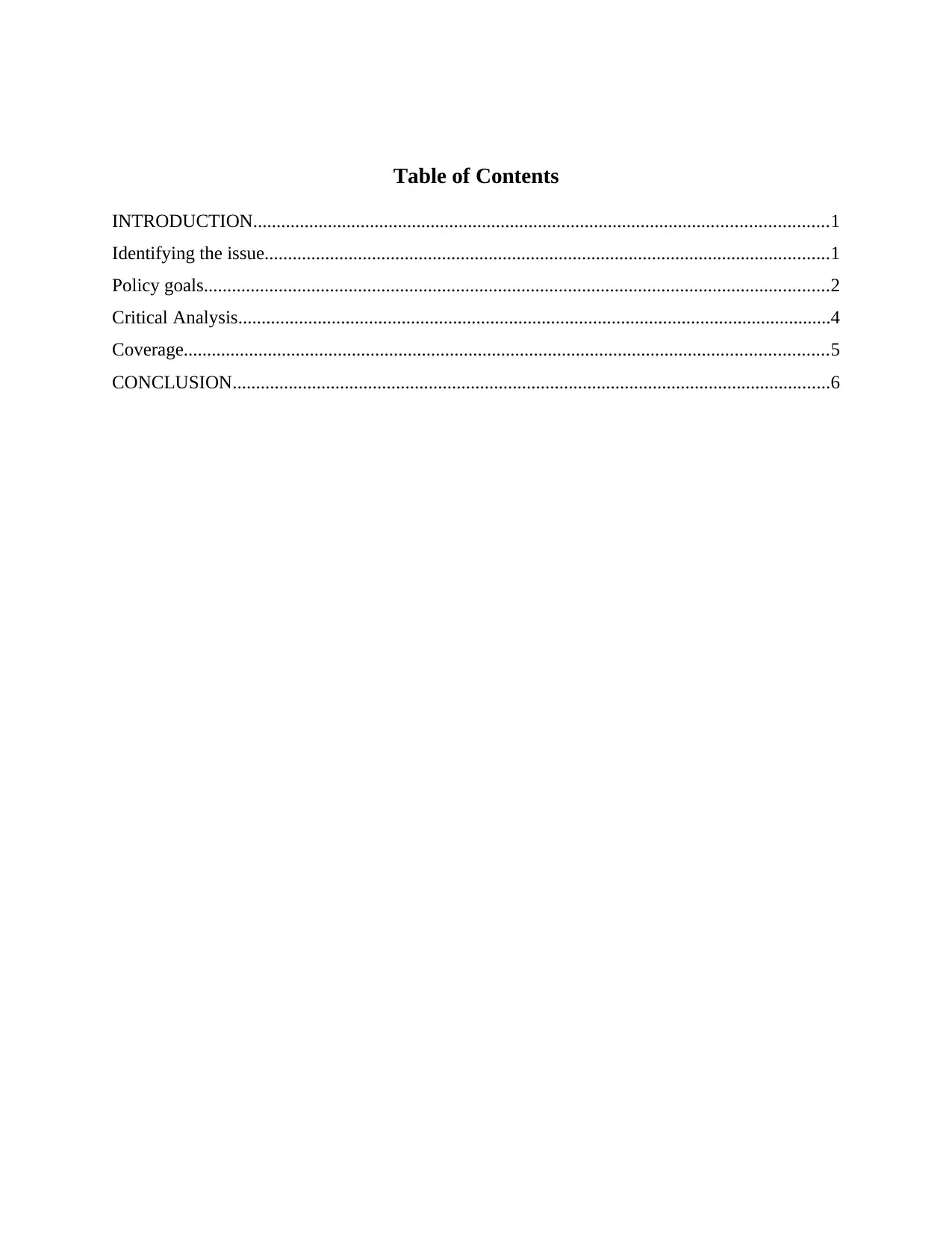
Table of Contents
INTRODUCTION...........................................................................................................................1
Identifying the issue.........................................................................................................................1
Policy goals......................................................................................................................................2
Critical Analysis...............................................................................................................................4
Coverage..........................................................................................................................................5
CONCLUSION................................................................................................................................6
INTRODUCTION...........................................................................................................................1
Identifying the issue.........................................................................................................................1
Policy goals......................................................................................................................................2
Critical Analysis...............................................................................................................................4
Coverage..........................................................................................................................................5
CONCLUSION................................................................................................................................6

INTRODUCTION
Crime in common terms indicates an act which is not lawful under law and is punishable
by the state to deter people from committing any such acts. Though, there is no clear universally
accepted definition of crime but the statutory definitions solves the purpose of explaining the
term. Governance refers to a process wherein the policies and decisions are taken by the
authorities to prevent crime and ensure welfare of the people. An anti-social behaviour could be
defined as annoying, irritating, disturbing or interfering behaviour creating a concern for the
community ranging from misuse of public places to being negligent about the community safety.
The report focuses on the issues of anti-social behaviour and involves the deviant
behaviours of minors which are either harmful, offensive or serious criminal activity, as it could
be witnessed that there is an increase in the anti-social behaviour among young.1 The report
underlines the government policies for keeping a check on such deviant behaviour.
Identifying the issue
In general terms the anti-social behaviour is a behaviour of an individual which could be
dangerous or harmful for a society or community, for instance, fighting in a public place or rash
and negligent driving could cause disturbance and be harmful for the community as a whole.
There are various definitions of anti-social behaviour given by various governments , department
and organs of the government, firstly, the definition given by the Western Australian Police
Department explains the term as “any behaviour which disturbs, annoys or interferes with a
persons' ability in going through their lawful business.”2 The another definition is given by the
British legislation as “behaviour causing or is likely to cause harassment, alarm or distress to one
or more people who are not in the same household as the perpetrator.”3
1
Indermaur David and Roberts Lynne, 'Confidence in the criminal justice system', (2010) Canberra : Australian
Institute of Criminology. <http://www.aic.gov.au/documents/D/6/8/%7BD68CD7EA-536A-4025-A8C0-
A5BADF59A6AC%7Dtandi387>
2
McAtamney A & Morgan A. (2010) Key issues in antisocial behaviour. Research in practice No. 5. Canberra:
Australian Institute of Criminology. <https://aic.gov.au/publications/rip/rip05>
3 Ibid 2.
1
Crime in common terms indicates an act which is not lawful under law and is punishable
by the state to deter people from committing any such acts. Though, there is no clear universally
accepted definition of crime but the statutory definitions solves the purpose of explaining the
term. Governance refers to a process wherein the policies and decisions are taken by the
authorities to prevent crime and ensure welfare of the people. An anti-social behaviour could be
defined as annoying, irritating, disturbing or interfering behaviour creating a concern for the
community ranging from misuse of public places to being negligent about the community safety.
The report focuses on the issues of anti-social behaviour and involves the deviant
behaviours of minors which are either harmful, offensive or serious criminal activity, as it could
be witnessed that there is an increase in the anti-social behaviour among young.1 The report
underlines the government policies for keeping a check on such deviant behaviour.
Identifying the issue
In general terms the anti-social behaviour is a behaviour of an individual which could be
dangerous or harmful for a society or community, for instance, fighting in a public place or rash
and negligent driving could cause disturbance and be harmful for the community as a whole.
There are various definitions of anti-social behaviour given by various governments , department
and organs of the government, firstly, the definition given by the Western Australian Police
Department explains the term as “any behaviour which disturbs, annoys or interferes with a
persons' ability in going through their lawful business.”2 The another definition is given by the
British legislation as “behaviour causing or is likely to cause harassment, alarm or distress to one
or more people who are not in the same household as the perpetrator.”3
1
Indermaur David and Roberts Lynne, 'Confidence in the criminal justice system', (2010) Canberra : Australian
Institute of Criminology. <http://www.aic.gov.au/documents/D/6/8/%7BD68CD7EA-536A-4025-A8C0-
A5BADF59A6AC%7Dtandi387>
2
McAtamney A & Morgan A. (2010) Key issues in antisocial behaviour. Research in practice No. 5. Canberra:
Australian Institute of Criminology. <https://aic.gov.au/publications/rip/rip05>
3 Ibid 2.
1
⊘ This is a preview!⊘
Do you want full access?
Subscribe today to unlock all pages.

Trusted by 1+ million students worldwide

The anti-social behaviour could be defined differently by different communities in
accordance to the implications it poses in that particular society as the set of behavioural patterns
ranging from minor issues, such as creating noise to serious issues, such as littering, destroying
public property etc. The anti-social behaviour discussed in the report is substance abuse and the
crimes or offences caused by drug abuse and its impacts in turn on the community; and what are
the strategies; and policies adopted by the government to curb the menace of substance abuse
followed by a response to policy goal.
The term substance abuse or drug abuse means the illegitimate consumption of legal or
illegal substances such as, misuse of prescribed drugs, use of illicit drugs, use of other illicit
substances etc. This leads to many diseases and could even cause death or disability and in turn
poses a risk to the user's family, neighbourhood and community at large.4 As the National Drug
Strategy Household Survey, 2016 reported that the consumption of illicit drugs in Australia is on
rise in spite of the consistent efforts taken by the government.5
Various types of illicit drugs
Cannabis commonly known as marijuana is a psychotropic substance derived from the
cannabis plant which is generally used for medicinal purposes. According to the Survey it is the
most commonly used drug amongst the youth. MDMA or ecstasy is also a psychotropic drug
which is illegal in most of the countries because of no medical use. This is a commonly used
drug which causes alterations in sensations. Hallucinogenic drugs such as LSD causes
hallucination on consumption. Heroin or Morphine are narcotic drugs which are used by many
countries for medicinal purposes, though, these are majorly used as the recreational drugs.
Synthetic drugs are resulted from man made processes and not naturally produced.
Most of the above mentioned drugs which are consumed by youth results in causing
difficulties pertaining to personal heath and social functioning also involves their increasing
engagement in anti-social behaviour, as there is a close nexus between drug consumption and
crime. The two could be said to have a direct effect on one another as consuming drugs might
lead to or cause crime or vice versa.
4 Illicit use of drugs, AIHW, https://www.aihw.gov.au/reports-statistics/behaviours-risk-factors/illicit-use-of-
drugs/overview; Last update on 15/01/2018
5 Drug trends and statistics, Australian Government Department of Health
https://campaigns.health.gov.au/drughelp/drug-trends-and-statistics; Last update on 15/01/2018
2
accordance to the implications it poses in that particular society as the set of behavioural patterns
ranging from minor issues, such as creating noise to serious issues, such as littering, destroying
public property etc. The anti-social behaviour discussed in the report is substance abuse and the
crimes or offences caused by drug abuse and its impacts in turn on the community; and what are
the strategies; and policies adopted by the government to curb the menace of substance abuse
followed by a response to policy goal.
The term substance abuse or drug abuse means the illegitimate consumption of legal or
illegal substances such as, misuse of prescribed drugs, use of illicit drugs, use of other illicit
substances etc. This leads to many diseases and could even cause death or disability and in turn
poses a risk to the user's family, neighbourhood and community at large.4 As the National Drug
Strategy Household Survey, 2016 reported that the consumption of illicit drugs in Australia is on
rise in spite of the consistent efforts taken by the government.5
Various types of illicit drugs
Cannabis commonly known as marijuana is a psychotropic substance derived from the
cannabis plant which is generally used for medicinal purposes. According to the Survey it is the
most commonly used drug amongst the youth. MDMA or ecstasy is also a psychotropic drug
which is illegal in most of the countries because of no medical use. This is a commonly used
drug which causes alterations in sensations. Hallucinogenic drugs such as LSD causes
hallucination on consumption. Heroin or Morphine are narcotic drugs which are used by many
countries for medicinal purposes, though, these are majorly used as the recreational drugs.
Synthetic drugs are resulted from man made processes and not naturally produced.
Most of the above mentioned drugs which are consumed by youth results in causing
difficulties pertaining to personal heath and social functioning also involves their increasing
engagement in anti-social behaviour, as there is a close nexus between drug consumption and
crime. The two could be said to have a direct effect on one another as consuming drugs might
lead to or cause crime or vice versa.
4 Illicit use of drugs, AIHW, https://www.aihw.gov.au/reports-statistics/behaviours-risk-factors/illicit-use-of-
drugs/overview; Last update on 15/01/2018
5 Drug trends and statistics, Australian Government Department of Health
https://campaigns.health.gov.au/drughelp/drug-trends-and-statistics; Last update on 15/01/2018
2
Paraphrase This Document
Need a fresh take? Get an instant paraphrase of this document with our AI Paraphraser
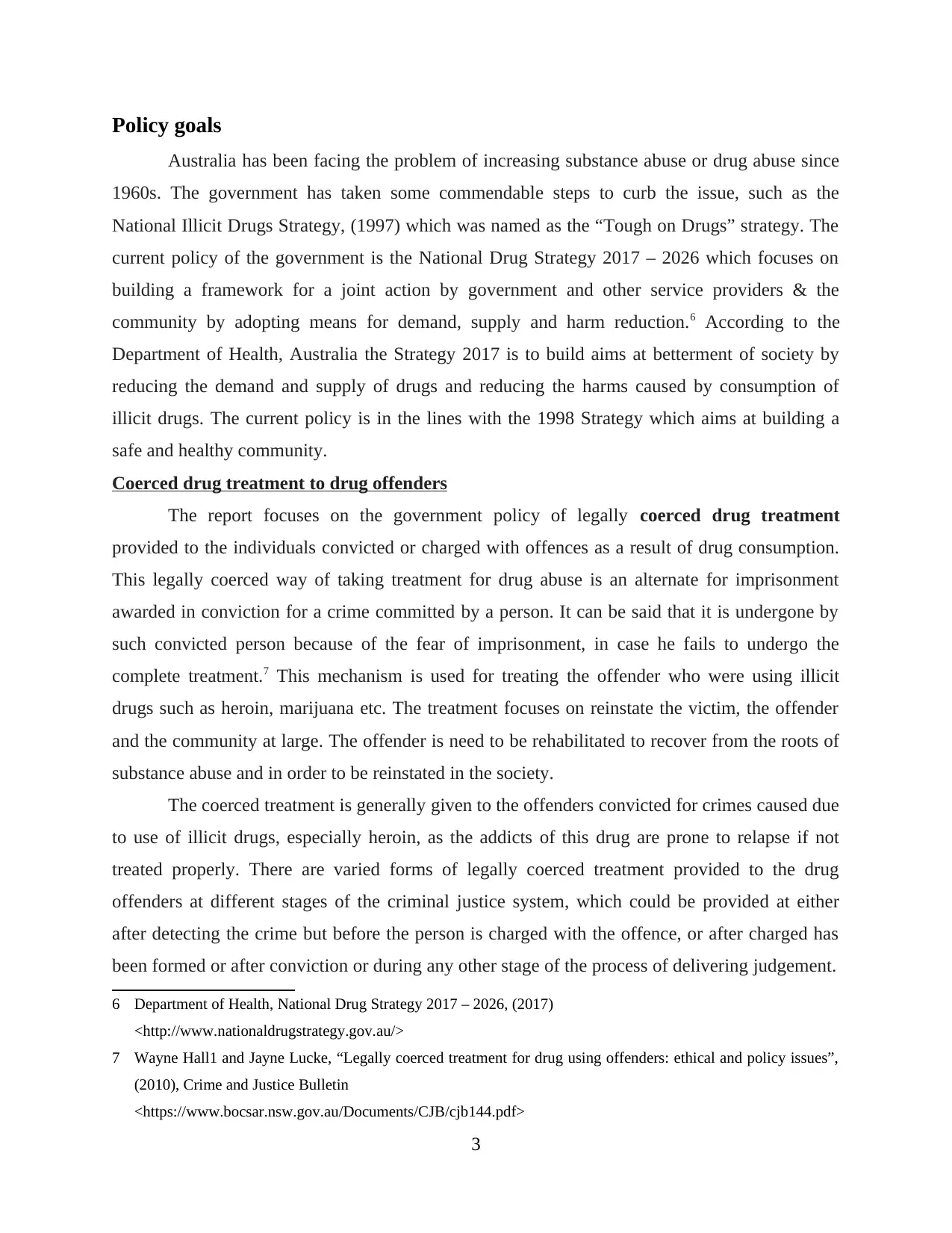
Policy goals
Australia has been facing the problem of increasing substance abuse or drug abuse since
1960s. The government has taken some commendable steps to curb the issue, such as the
National Illicit Drugs Strategy, (1997) which was named as the “Tough on Drugs” strategy. The
current policy of the government is the National Drug Strategy 2017 – 2026 which focuses on
building a framework for a joint action by government and other service providers & the
community by adopting means for demand, supply and harm reduction.6 According to the
Department of Health, Australia the Strategy 2017 is to build aims at betterment of society by
reducing the demand and supply of drugs and reducing the harms caused by consumption of
illicit drugs. The current policy is in the lines with the 1998 Strategy which aims at building a
safe and healthy community.
Coerced drug treatment to drug offenders
The report focuses on the government policy of legally coerced drug treatment
provided to the individuals convicted or charged with offences as a result of drug consumption.
This legally coerced way of taking treatment for drug abuse is an alternate for imprisonment
awarded in conviction for a crime committed by a person. It can be said that it is undergone by
such convicted person because of the fear of imprisonment, in case he fails to undergo the
complete treatment.7 This mechanism is used for treating the offender who were using illicit
drugs such as heroin, marijuana etc. The treatment focuses on reinstate the victim, the offender
and the community at large. The offender is need to be rehabilitated to recover from the roots of
substance abuse and in order to be reinstated in the society.
The coerced treatment is generally given to the offenders convicted for crimes caused due
to use of illicit drugs, especially heroin, as the addicts of this drug are prone to relapse if not
treated properly. There are varied forms of legally coerced treatment provided to the drug
offenders at different stages of the criminal justice system, which could be provided at either
after detecting the crime but before the person is charged with the offence, or after charged has
been formed or after conviction or during any other stage of the process of delivering judgement.
6 Department of Health, National Drug Strategy 2017 – 2026, (2017)
<http://www.nationaldrugstrategy.gov.au/>
7 Wayne Hall1 and Jayne Lucke, “Legally coerced treatment for drug using offenders: ethical and policy issues”,
(2010), Crime and Justice Bulletin
<https://www.bocsar.nsw.gov.au/Documents/CJB/cjb144.pdf>
3
Australia has been facing the problem of increasing substance abuse or drug abuse since
1960s. The government has taken some commendable steps to curb the issue, such as the
National Illicit Drugs Strategy, (1997) which was named as the “Tough on Drugs” strategy. The
current policy of the government is the National Drug Strategy 2017 – 2026 which focuses on
building a framework for a joint action by government and other service providers & the
community by adopting means for demand, supply and harm reduction.6 According to the
Department of Health, Australia the Strategy 2017 is to build aims at betterment of society by
reducing the demand and supply of drugs and reducing the harms caused by consumption of
illicit drugs. The current policy is in the lines with the 1998 Strategy which aims at building a
safe and healthy community.
Coerced drug treatment to drug offenders
The report focuses on the government policy of legally coerced drug treatment
provided to the individuals convicted or charged with offences as a result of drug consumption.
This legally coerced way of taking treatment for drug abuse is an alternate for imprisonment
awarded in conviction for a crime committed by a person. It can be said that it is undergone by
such convicted person because of the fear of imprisonment, in case he fails to undergo the
complete treatment.7 This mechanism is used for treating the offender who were using illicit
drugs such as heroin, marijuana etc. The treatment focuses on reinstate the victim, the offender
and the community at large. The offender is need to be rehabilitated to recover from the roots of
substance abuse and in order to be reinstated in the society.
The coerced treatment is generally given to the offenders convicted for crimes caused due
to use of illicit drugs, especially heroin, as the addicts of this drug are prone to relapse if not
treated properly. There are varied forms of legally coerced treatment provided to the drug
offenders at different stages of the criminal justice system, which could be provided at either
after detecting the crime but before the person is charged with the offence, or after charged has
been formed or after conviction or during any other stage of the process of delivering judgement.
6 Department of Health, National Drug Strategy 2017 – 2026, (2017)
<http://www.nationaldrugstrategy.gov.au/>
7 Wayne Hall1 and Jayne Lucke, “Legally coerced treatment for drug using offenders: ethical and policy issues”,
(2010), Crime and Justice Bulletin
<https://www.bocsar.nsw.gov.au/Documents/CJB/cjb144.pdf>
3
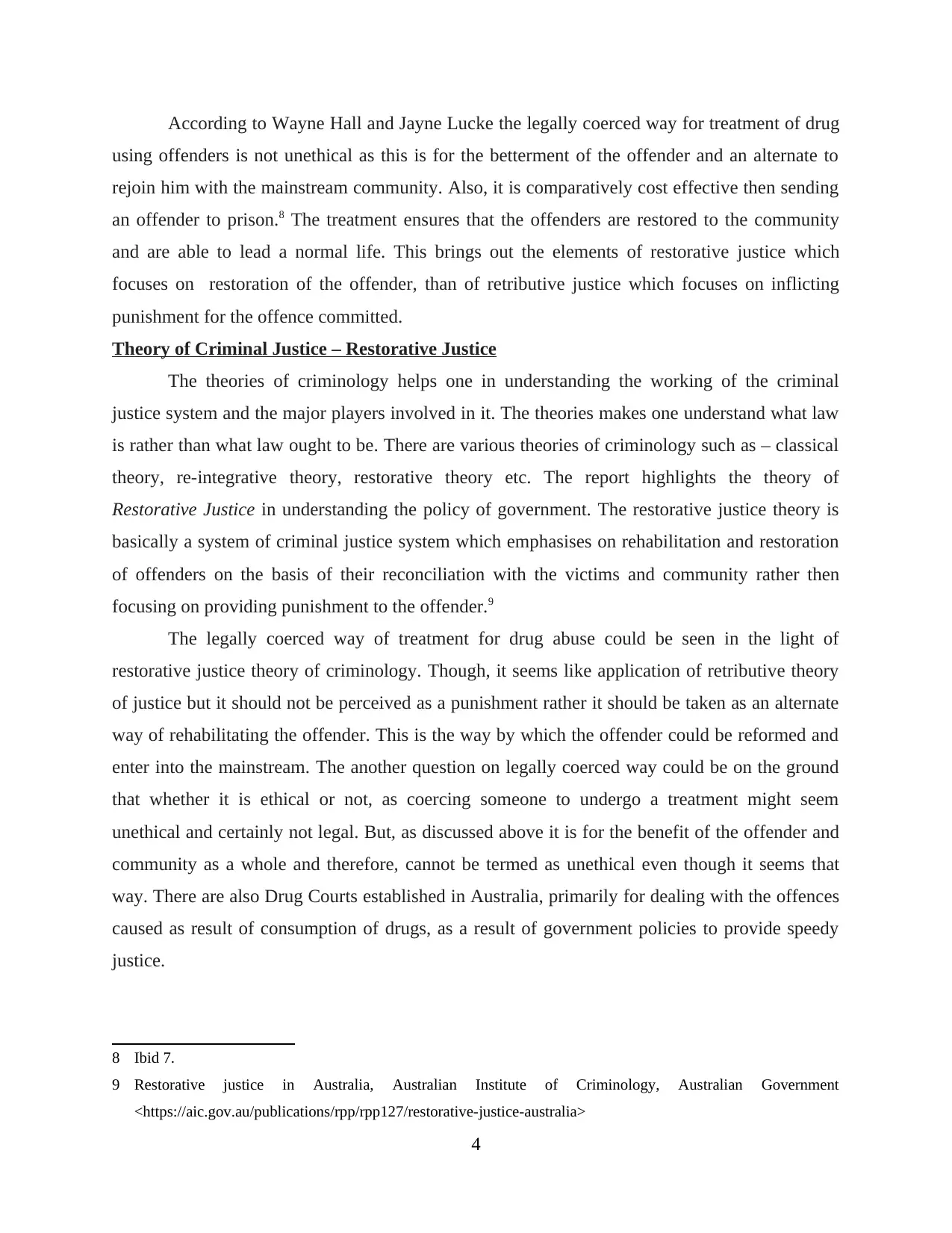
According to Wayne Hall and Jayne Lucke the legally coerced way for treatment of drug
using offenders is not unethical as this is for the betterment of the offender and an alternate to
rejoin him with the mainstream community. Also, it is comparatively cost effective then sending
an offender to prison.8 The treatment ensures that the offenders are restored to the community
and are able to lead a normal life. This brings out the elements of restorative justice which
focuses on restoration of the offender, than of retributive justice which focuses on inflicting
punishment for the offence committed.
Theory of Criminal Justice – Restorative Justice
The theories of criminology helps one in understanding the working of the criminal
justice system and the major players involved in it. The theories makes one understand what law
is rather than what law ought to be. There are various theories of criminology such as – classical
theory, re-integrative theory, restorative theory etc. The report highlights the theory of
Restorative Justice in understanding the policy of government. The restorative justice theory is
basically a system of criminal justice system which emphasises on rehabilitation and restoration
of offenders on the basis of their reconciliation with the victims and community rather then
focusing on providing punishment to the offender.9
The legally coerced way of treatment for drug abuse could be seen in the light of
restorative justice theory of criminology. Though, it seems like application of retributive theory
of justice but it should not be perceived as a punishment rather it should be taken as an alternate
way of rehabilitating the offender. This is the way by which the offender could be reformed and
enter into the mainstream. The another question on legally coerced way could be on the ground
that whether it is ethical or not, as coercing someone to undergo a treatment might seem
unethical and certainly not legal. But, as discussed above it is for the benefit of the offender and
community as a whole and therefore, cannot be termed as unethical even though it seems that
way. There are also Drug Courts established in Australia, primarily for dealing with the offences
caused as result of consumption of drugs, as a result of government policies to provide speedy
justice.
8 Ibid 7.
9 Restorative justice in Australia, Australian Institute of Criminology, Australian Government
<https://aic.gov.au/publications/rpp/rpp127/restorative-justice-australia>
4
using offenders is not unethical as this is for the betterment of the offender and an alternate to
rejoin him with the mainstream community. Also, it is comparatively cost effective then sending
an offender to prison.8 The treatment ensures that the offenders are restored to the community
and are able to lead a normal life. This brings out the elements of restorative justice which
focuses on restoration of the offender, than of retributive justice which focuses on inflicting
punishment for the offence committed.
Theory of Criminal Justice – Restorative Justice
The theories of criminology helps one in understanding the working of the criminal
justice system and the major players involved in it. The theories makes one understand what law
is rather than what law ought to be. There are various theories of criminology such as – classical
theory, re-integrative theory, restorative theory etc. The report highlights the theory of
Restorative Justice in understanding the policy of government. The restorative justice theory is
basically a system of criminal justice system which emphasises on rehabilitation and restoration
of offenders on the basis of their reconciliation with the victims and community rather then
focusing on providing punishment to the offender.9
The legally coerced way of treatment for drug abuse could be seen in the light of
restorative justice theory of criminology. Though, it seems like application of retributive theory
of justice but it should not be perceived as a punishment rather it should be taken as an alternate
way of rehabilitating the offender. This is the way by which the offender could be reformed and
enter into the mainstream. The another question on legally coerced way could be on the ground
that whether it is ethical or not, as coercing someone to undergo a treatment might seem
unethical and certainly not legal. But, as discussed above it is for the benefit of the offender and
community as a whole and therefore, cannot be termed as unethical even though it seems that
way. There are also Drug Courts established in Australia, primarily for dealing with the offences
caused as result of consumption of drugs, as a result of government policies to provide speedy
justice.
8 Ibid 7.
9 Restorative justice in Australia, Australian Institute of Criminology, Australian Government
<https://aic.gov.au/publications/rpp/rpp127/restorative-justice-australia>
4
⊘ This is a preview!⊘
Do you want full access?
Subscribe today to unlock all pages.

Trusted by 1+ million students worldwide
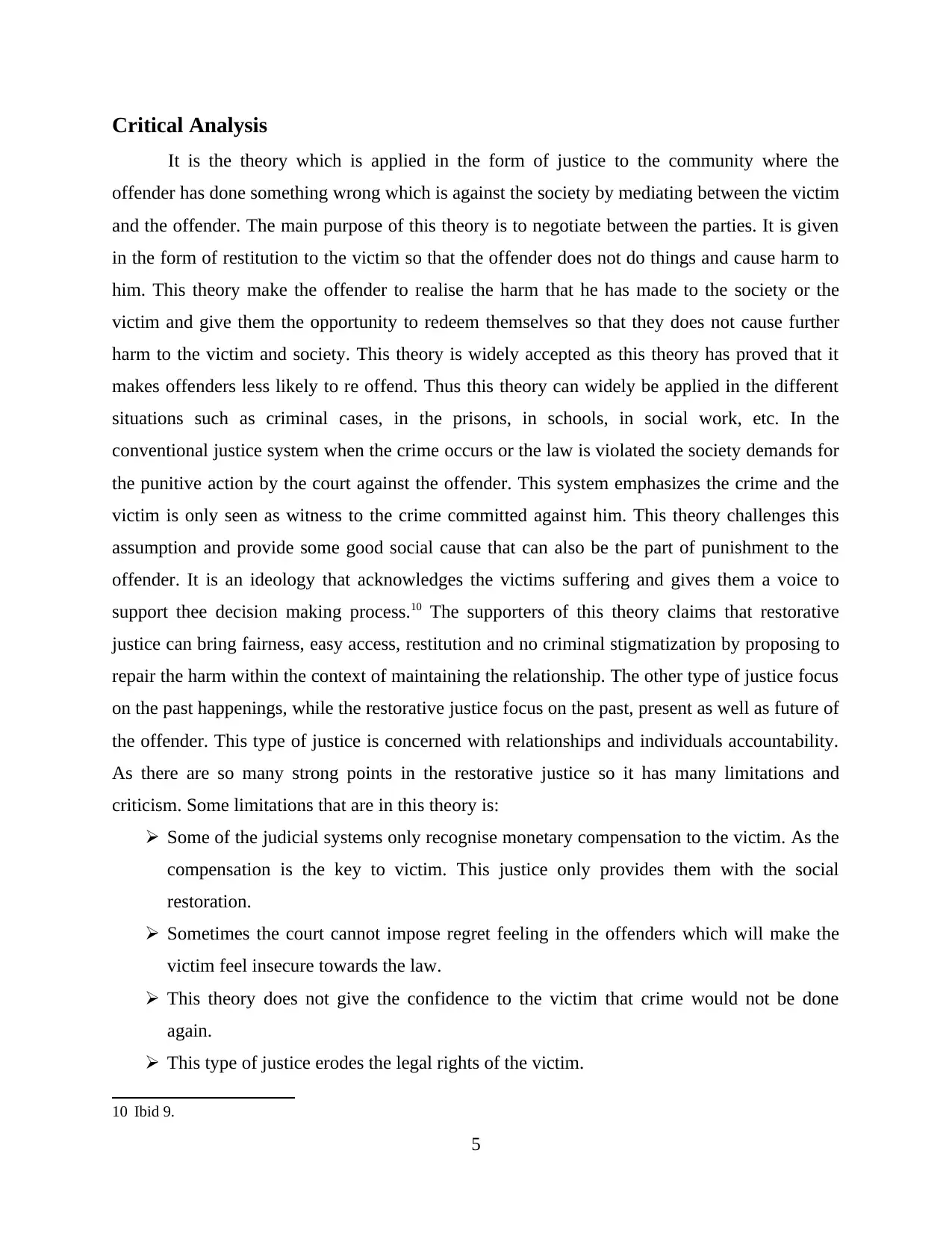
Critical Analysis
It is the theory which is applied in the form of justice to the community where the
offender has done something wrong which is against the society by mediating between the victim
and the offender. The main purpose of this theory is to negotiate between the parties. It is given
in the form of restitution to the victim so that the offender does not do things and cause harm to
him. This theory make the offender to realise the harm that he has made to the society or the
victim and give them the opportunity to redeem themselves so that they does not cause further
harm to the victim and society. This theory is widely accepted as this theory has proved that it
makes offenders less likely to re offend. Thus this theory can widely be applied in the different
situations such as criminal cases, in the prisons, in schools, in social work, etc. In the
conventional justice system when the crime occurs or the law is violated the society demands for
the punitive action by the court against the offender. This system emphasizes the crime and the
victim is only seen as witness to the crime committed against him. This theory challenges this
assumption and provide some good social cause that can also be the part of punishment to the
offender. It is an ideology that acknowledges the victims suffering and gives them a voice to
support thee decision making process.10 The supporters of this theory claims that restorative
justice can bring fairness, easy access, restitution and no criminal stigmatization by proposing to
repair the harm within the context of maintaining the relationship. The other type of justice focus
on the past happenings, while the restorative justice focus on the past, present as well as future of
the offender. This type of justice is concerned with relationships and individuals accountability.
As there are so many strong points in the restorative justice so it has many limitations and
criticism. Some limitations that are in this theory is:
Some of the judicial systems only recognise monetary compensation to the victim. As the
compensation is the key to victim. This justice only provides them with the social
restoration.
Sometimes the court cannot impose regret feeling in the offenders which will make the
victim feel insecure towards the law.
This theory does not give the confidence to the victim that crime would not be done
again.
This type of justice erodes the legal rights of the victim.
10 Ibid 9.
5
It is the theory which is applied in the form of justice to the community where the
offender has done something wrong which is against the society by mediating between the victim
and the offender. The main purpose of this theory is to negotiate between the parties. It is given
in the form of restitution to the victim so that the offender does not do things and cause harm to
him. This theory make the offender to realise the harm that he has made to the society or the
victim and give them the opportunity to redeem themselves so that they does not cause further
harm to the victim and society. This theory is widely accepted as this theory has proved that it
makes offenders less likely to re offend. Thus this theory can widely be applied in the different
situations such as criminal cases, in the prisons, in schools, in social work, etc. In the
conventional justice system when the crime occurs or the law is violated the society demands for
the punitive action by the court against the offender. This system emphasizes the crime and the
victim is only seen as witness to the crime committed against him. This theory challenges this
assumption and provide some good social cause that can also be the part of punishment to the
offender. It is an ideology that acknowledges the victims suffering and gives them a voice to
support thee decision making process.10 The supporters of this theory claims that restorative
justice can bring fairness, easy access, restitution and no criminal stigmatization by proposing to
repair the harm within the context of maintaining the relationship. The other type of justice focus
on the past happenings, while the restorative justice focus on the past, present as well as future of
the offender. This type of justice is concerned with relationships and individuals accountability.
As there are so many strong points in the restorative justice so it has many limitations and
criticism. Some limitations that are in this theory is:
Some of the judicial systems only recognise monetary compensation to the victim. As the
compensation is the key to victim. This justice only provides them with the social
restoration.
Sometimes the court cannot impose regret feeling in the offenders which will make the
victim feel insecure towards the law.
This theory does not give the confidence to the victim that crime would not be done
again.
This type of justice erodes the legal rights of the victim.
10 Ibid 9.
5
Paraphrase This Document
Need a fresh take? Get an instant paraphrase of this document with our AI Paraphraser
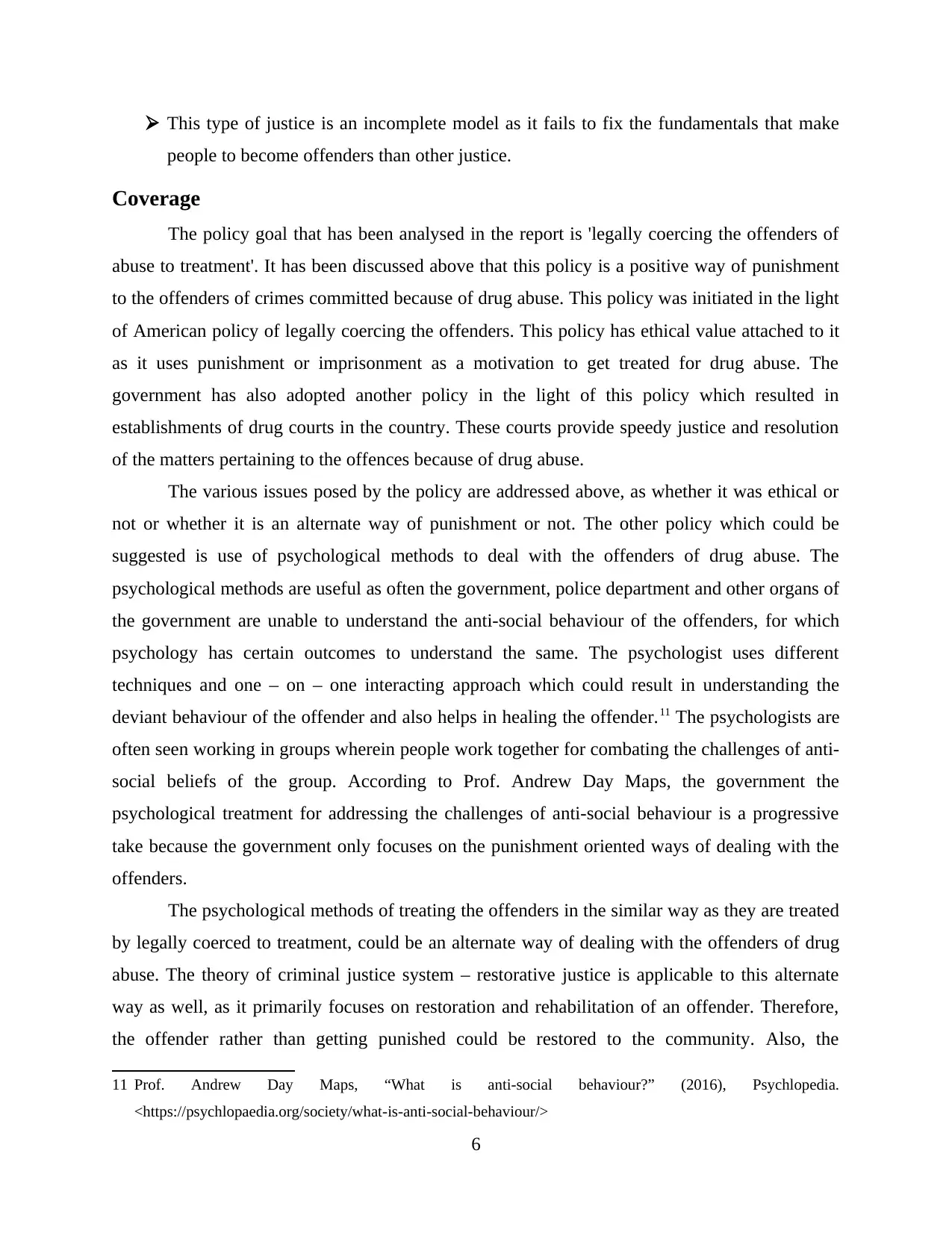
This type of justice is an incomplete model as it fails to fix the fundamentals that make
people to become offenders than other justice.
Coverage
The policy goal that has been analysed in the report is 'legally coercing the offenders of
abuse to treatment'. It has been discussed above that this policy is a positive way of punishment
to the offenders of crimes committed because of drug abuse. This policy was initiated in the light
of American policy of legally coercing the offenders. This policy has ethical value attached to it
as it uses punishment or imprisonment as a motivation to get treated for drug abuse. The
government has also adopted another policy in the light of this policy which resulted in
establishments of drug courts in the country. These courts provide speedy justice and resolution
of the matters pertaining to the offences because of drug abuse.
The various issues posed by the policy are addressed above, as whether it was ethical or
not or whether it is an alternate way of punishment or not. The other policy which could be
suggested is use of psychological methods to deal with the offenders of drug abuse. The
psychological methods are useful as often the government, police department and other organs of
the government are unable to understand the anti-social behaviour of the offenders, for which
psychology has certain outcomes to understand the same. The psychologist uses different
techniques and one – on – one interacting approach which could result in understanding the
deviant behaviour of the offender and also helps in healing the offender.11 The psychologists are
often seen working in groups wherein people work together for combating the challenges of anti-
social beliefs of the group. According to Prof. Andrew Day Maps, the government the
psychological treatment for addressing the challenges of anti-social behaviour is a progressive
take because the government only focuses on the punishment oriented ways of dealing with the
offenders.
The psychological methods of treating the offenders in the similar way as they are treated
by legally coerced to treatment, could be an alternate way of dealing with the offenders of drug
abuse. The theory of criminal justice system – restorative justice is applicable to this alternate
way as well, as it primarily focuses on restoration and rehabilitation of an offender. Therefore,
the offender rather than getting punished could be restored to the community. Also, the
11 Prof. Andrew Day Maps, “What is anti-social behaviour?” (2016), Psychlopedia.
<https://psychlopaedia.org/society/what-is-anti-social-behaviour/>
6
people to become offenders than other justice.
Coverage
The policy goal that has been analysed in the report is 'legally coercing the offenders of
abuse to treatment'. It has been discussed above that this policy is a positive way of punishment
to the offenders of crimes committed because of drug abuse. This policy was initiated in the light
of American policy of legally coercing the offenders. This policy has ethical value attached to it
as it uses punishment or imprisonment as a motivation to get treated for drug abuse. The
government has also adopted another policy in the light of this policy which resulted in
establishments of drug courts in the country. These courts provide speedy justice and resolution
of the matters pertaining to the offences because of drug abuse.
The various issues posed by the policy are addressed above, as whether it was ethical or
not or whether it is an alternate way of punishment or not. The other policy which could be
suggested is use of psychological methods to deal with the offenders of drug abuse. The
psychological methods are useful as often the government, police department and other organs of
the government are unable to understand the anti-social behaviour of the offenders, for which
psychology has certain outcomes to understand the same. The psychologist uses different
techniques and one – on – one interacting approach which could result in understanding the
deviant behaviour of the offender and also helps in healing the offender.11 The psychologists are
often seen working in groups wherein people work together for combating the challenges of anti-
social beliefs of the group. According to Prof. Andrew Day Maps, the government the
psychological treatment for addressing the challenges of anti-social behaviour is a progressive
take because the government only focuses on the punishment oriented ways of dealing with the
offenders.
The psychological methods of treating the offenders in the similar way as they are treated
by legally coerced to treatment, could be an alternate way of dealing with the offenders of drug
abuse. The theory of criminal justice system – restorative justice is applicable to this alternate
way as well, as it primarily focuses on restoration and rehabilitation of an offender. Therefore,
the offender rather than getting punished could be restored to the community. Also, the
11 Prof. Andrew Day Maps, “What is anti-social behaviour?” (2016), Psychlopedia.
<https://psychlopaedia.org/society/what-is-anti-social-behaviour/>
6
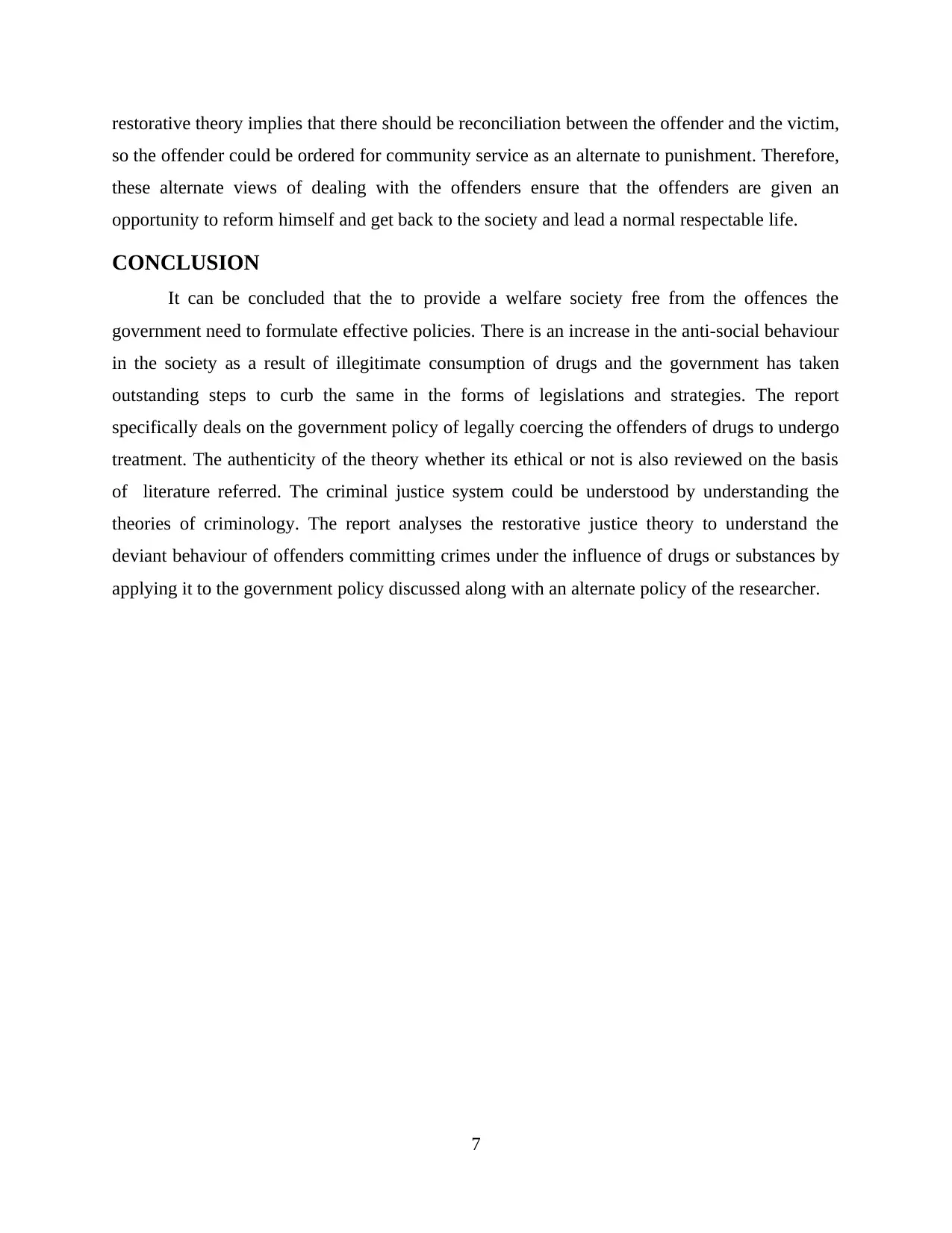
restorative theory implies that there should be reconciliation between the offender and the victim,
so the offender could be ordered for community service as an alternate to punishment. Therefore,
these alternate views of dealing with the offenders ensure that the offenders are given an
opportunity to reform himself and get back to the society and lead a normal respectable life.
CONCLUSION
It can be concluded that the to provide a welfare society free from the offences the
government need to formulate effective policies. There is an increase in the anti-social behaviour
in the society as a result of illegitimate consumption of drugs and the government has taken
outstanding steps to curb the same in the forms of legislations and strategies. The report
specifically deals on the government policy of legally coercing the offenders of drugs to undergo
treatment. The authenticity of the theory whether its ethical or not is also reviewed on the basis
of literature referred. The criminal justice system could be understood by understanding the
theories of criminology. The report analyses the restorative justice theory to understand the
deviant behaviour of offenders committing crimes under the influence of drugs or substances by
applying it to the government policy discussed along with an alternate policy of the researcher.
7
so the offender could be ordered for community service as an alternate to punishment. Therefore,
these alternate views of dealing with the offenders ensure that the offenders are given an
opportunity to reform himself and get back to the society and lead a normal respectable life.
CONCLUSION
It can be concluded that the to provide a welfare society free from the offences the
government need to formulate effective policies. There is an increase in the anti-social behaviour
in the society as a result of illegitimate consumption of drugs and the government has taken
outstanding steps to curb the same in the forms of legislations and strategies. The report
specifically deals on the government policy of legally coercing the offenders of drugs to undergo
treatment. The authenticity of the theory whether its ethical or not is also reviewed on the basis
of literature referred. The criminal justice system could be understood by understanding the
theories of criminology. The report analyses the restorative justice theory to understand the
deviant behaviour of offenders committing crimes under the influence of drugs or substances by
applying it to the government policy discussed along with an alternate policy of the researcher.
7
⊘ This is a preview!⊘
Do you want full access?
Subscribe today to unlock all pages.

Trusted by 1+ million students worldwide
1 out of 9
Related Documents
Your All-in-One AI-Powered Toolkit for Academic Success.
+13062052269
info@desklib.com
Available 24*7 on WhatsApp / Email
![[object Object]](/_next/static/media/star-bottom.7253800d.svg)
Unlock your academic potential
Copyright © 2020–2025 A2Z Services. All Rights Reserved. Developed and managed by ZUCOL.



